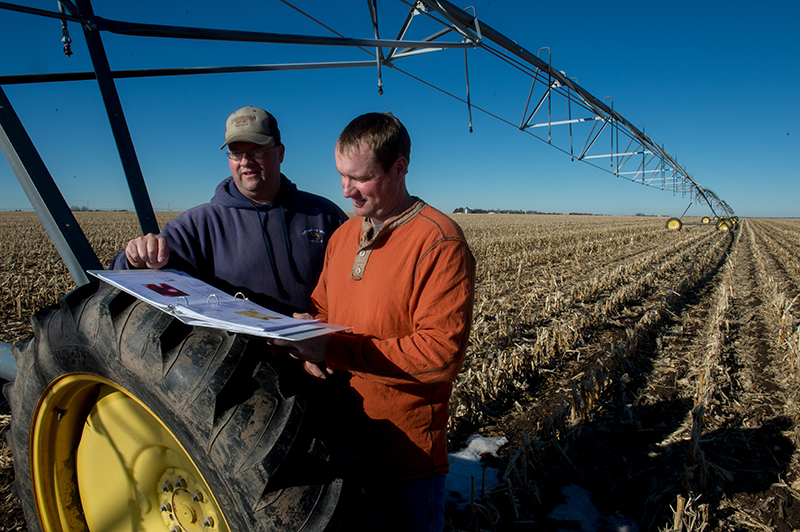Dicamba Update: Resistance Prevention and the Credit Card
CropLife sat down with Daniel Waldstein, Technical Marketing Manager, BASF, at Commodity Classic in Orlando, FL, and chatted on topics such as dicamba stewardship (which is where the credit card comes in), and BASF’s support of ag retailers in training, including the tricky area of dealing with neighbors.
CL: Are people being more proactive with dicamba on preventing resistance than they were with glyphosate?
It’s really been in the last week or two, I’ve had a lot more talk about resistance just in general. There was a population of waterhemp in Missouri that has resistance to six different classes of herbicides, and it’s obviously cause for concern for us. But a couple of different chemistries that fit well in our portfolio of dicamba with Engenia and glufosinate with Liberty, were effective at controlling that population of waterhemp in Missouri. Another more recent case, at a couple of research fields in Illinois, we heard about some Group-15 resistance. Residual chemistries in Group 15 are Outlook and Zidua.
In the last couple of weeks we’ve had a lot of conversations just within our company about strategies, best practices, and best paths to move forward. We talked a lot about continuing to use residuals pre and post, and really layering residuals, because part of what they’re seeing at some of those sites where they have these superweeds, is that residual herbicides are still effective at helping control the populations. We’re going to lean pretty heavily on the dicamba chemistry and even the glufosinate chemistry in the next few years, so we’ve got to really look at using multiple modes of action and tank mixes and premixes – even looking at non-chemical strategies such as narrow-row spacing, which helps with making the crop more competitive and getting canopy closure faster.
BASF is really committed to innovations, and I think we’ve got one of the strongest if not strongest development pipelines in the industry. But we always try to help growers and agronomists understand that there’s not a silver bullet that’s going to come out in succession. We can’t afford to burn through the remaining tools we have left. We need to steward those properly so they’re effective in the long term, not just a couple of years like we saw with glyphosate.
I think we’ve learned a lot over the years. It’s just a matter of trying to work through some of the challenges. With commodity prices being lower, a lot of growers are looking at cutting costs and cutting corners, but I think it’s a double-edged sword. When you cut some of those inputs, you have potentially more challenges in controlling your weeds. You have a harder time getting yields you need to be profitable.
CL: What have you heard at this show about already trying to prevent dicamba resistance?
My sense is that a few years ago, we talked about herbicide resistance and resistance management. People knew it was an issue, but it was almost, to many growers out there, more of a luxury. I think now growers are starting to realize it’s a necessity, not a luxury to have a plant program that considers resistance and having multiple modes of action, and using residuals pre and post.
We’ve talked more about weed size in recent years, and it hits home well. With Engenia, you’re talking about 4-inch weeds. Weeds like Palmer and waterhemp can grow an inch or 2 inches a day under ideal conditions, so that’s where the residual chemistry comes in. It gives you that extra margin for error vs. a post-only program – you get two, three, four days of rain, and can’t get in the field for a week. You’ve already got weeds out of control, unless you’ve started out with a good residual program. I think that’s the take-home message we’re trying to convey to growers.
 One of the illustrations I like to use is on weed size. We always joke that when we get a call from a grower, we ask how big the weeds are, and they say they’re 4-inch-tall weeds. I use a credit card, which is 3-3/8 inches. With Liberty, we talk about 3-inch-tall weeds, and with Engenia, it’s 4 inches. It puts it in perspective, because I think a lot of the time, people don’t realize that’s a pretty small weed.
One of the illustrations I like to use is on weed size. We always joke that when we get a call from a grower, we ask how big the weeds are, and they say they’re 4-inch-tall weeds. I use a credit card, which is 3-3/8 inches. With Liberty, we talk about 3-inch-tall weeds, and with Engenia, it’s 4 inches. It puts it in perspective, because I think a lot of the time, people don’t realize that’s a pretty small weed.
I talk to individuals who have been at our company for decades. When glyphosate came out, a lot of times growers let the weeds grow bigger so they wouldn’t have to spray weeds more than two times. Basically, it’s almost the opposite of what we’re trying to get them to do now: go after smaller weeds, use a residual. There’s a mindset change, and I think you’re starting to see some traction, but it takes time. You can’t get that almost total cultural change overnight.
CL: Also, they are having to manage so many other aspects with the technology, regulatory in particular.
Exactly. There are so many things in today’s farming operations; it’s so complex. That’s why we want to be there to help provide the expertise. We’ve got a lot of business reps, innovation specialists, and tech reps in the field. That’s part of their job, to help customers be successful and provide that expertise that they may or may not have.
CL: Can you talk more about BASF’s support of ag retailers, and how you help them manage dicamba in 2019?
Our business reps’ primary face-to-face interaction is with the ag retailer. Our innovation specialists primarily work with growers directly, and then our tech reps are the technical resource and they work with all of our customer, whether it’s an ag retailer or directly with a grower.
A huge component of our success with Engenia has been our training program. We’ve trained thousands of people over the last couple years. It’s a monumental effort, but kudos to our tech reps and field sales teams. They do an excellent job at providing that high-level training. A lot of that is face-to-face training in groups, which can be challenging because there are only so many meetings we can conduct over the winter time. We have some online training that’s available now, and a lot of the states allow people to take that. Some states require a face-to-face training. We’ve got to work within that state regulatory framework.
Our engeniastewardship.com is a one-stop-shop for tank-mix information, regulatory updates, label changes, and more. There are so many tank-mix partners and I get weekly updates on those. It’s a living, dynamic website. That’s really what we need for our customers.
CL: Are you optimistic that this year we won’t see quite as many issues as in the previous two years?
I think in the areas you’ve seen success can largely be attributed to people engaging in the training and really understanding and taking seriously the best-use practices, not only for having good neighbors and minimizing off-target movement, but just having the technology work effectively. They’re paying a certain amount, they want it to go where it’s intended, and that’s where it’s going to be most effective.
I think we’re definitely gaining ground. As time goes by, those training efforts are really starting to cause people to appreciate the technology and how it should be used, and on the other hand, how it should not be used.
We’ve had a lot of positive feedback on the weed control part of Engenia technology. Again, it’s a matter of being good stewards of that technology and being good neighbors. We all live in a community; we want to have good relationships with our neighbors.
CL: Do you talk a lot about that in the training on how to approach and interact with your neighbor? It seems trickier.
It is – it’s more like social science than natural science. As chemists and biologists, that’s where we play, and not so much the sociology part of it. We’ve had some training on interactions and how to deal with a situation when it becomes stressful or even contentious. One of the things that certainly help when our growers or applicators get in that type of situation, is that we can bring in somebody – a tech rep in the field that’s had experience dealing with difficult situations. They’re really trying to just gather information and figure out what we can do better, or what we can do to avoid having an issue.
That said, these are stressful times in farming and agriculture. There’re always times when people struggle through a challenging situation, but I think we have been receiving a lot of positive feedback in our interactions. Being there when growers and ag retailers need that kind of help, and not just selling them the product and then walking away, saying, ‘you’re on your own – hope it goes well!’ That’s not the relationship we’ve been cultivating. Our tech and business reps live in those communities, too. They want to be good neighbors as much as anybody. I think it’s that kind of mindset we’re trying to carry out day to day in our business dealings.






